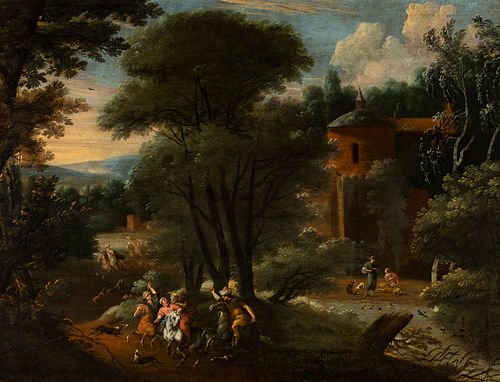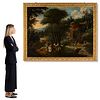French school of the second half of the 17th century. "Arab assailants". Oil on canvas. Re-framed. Size: 118 x 152 cm; 135 x 170 cm (frame).
Lot 154
About Seller
Setdart Auction House
Carrer Aragó 346
Barcelona
Spain
Setdart Subastas was born in 2004 and is currently the first online art auction in Spain with solidity, prestige and reliability guaranteed by our more than 60,000 users. Setdart has a young, dynamic and enterprising team ready to successfully manage the purchase and sale of art works through custom...Read more
Estimate:
EUR€10,000 - EUR€12,000
$10,416.67 - $12,500
Absentee vs Live bid
Two ways to bid:
- Leave a max absentee bid and the platform will bid on your behalf up to your maximum bid during the live auction.
- Bid live during the auction and your bids will be submitted real-time to the auctioneer.
Bid Increments
| Price | Bid Increment |
|---|---|
| EUR€0 | EUR€10 |
| EUR€200 | EUR€25 |
| EUR€500 | EUR€50 |
| EUR€1,000 | EUR€100 |
| EUR€3,000 | EUR€200 |
| EUR€5,000 | EUR€500 |
| EUR€10,000 | EUR€1,000 |
| EUR€20,000 | EUR€2,000 |
| EUR€50,000 | EUR€5,000 |
About Auction
By Setdart Auction House
Oct 20, 2021
Set Reminder
2021-10-20 07:30:00
2021-10-20 07:30:00
America/New_York
Bidsquare
Bidsquare : OLD MASTERS
https://www.bidsquare.com/auctions/setdart-auction-house/old-masters-7700
Setdart Auction House sofia@setdart.com
Setdart Auction House sofia@setdart.com
- Lot Description
French school of the second half of the 17th century. "Arab assailants". Oil on canvas. Re-framed. Size: 118 x 152 cm; 135 x 170 cm (frame). The artistic and cultural splendour of the Turkish Empire in the 17th-18th centuries and its subsequent influence throughout Europe was due, in part, to its Mediterranean fleet, which came to dominate the eastern Mediterranean and a large part of the Arabian Gulf. As a result, European artists saw the Turkish region as an inexhaustible source of inspiration due to its cultural and aesthetic differences from Europe, its luminosity, etc. Many painters brought exoticism to their works, giving rise to male types such as the present ones. In the present canvas, a group of characters dressed in Turkish fashion are hunting by the calm waters of a stream. One of the figures is attacked by a fierce animal that claws at his torso, while his compatriots struggle desperately to put the ferocious beast down. The scene takes place in a magnificent landscape dominated by nature, with a scenographic composition captured from a high viewpoint that allows a detailed view of the different shots. They follow one another in depth, marking a dynamic zigzag that avoids compositional monotony, and in them light and shadow alternate in a very effective way, in keeping with the scenographic conception of nature. From the cave paintings until the 18th century, nature rarely appeared in pictorial works as a landscape in its own right. Chinese artists, from the 5th century onwards, are credited with 'discovering' landscape as a pictorial element, influenced by Buddhism and its conception of nature. In Europe, however, it was not until the Renaissance that landscape came to the fore, gradually increasing its presence in works of art and becoming an object of interest in its own right rather than as a background for a religious composition or a portrait. But it did not gain the status of a pictorial genre until the 17th century in Holland, a country that developed an important landscape school. In the 19th century, the Dutch example became universal, becoming one of the objectives of pictorial realism, especially in France through the Barbizon School and Plenilirism. This new interest in capturing a fleeting moment of light or an anecdote in the midst of nature led to the use of techniques such as watercolour, which was quicker to execute, and loose brushstrokes in an attempt to achieve an impression rather than a drawing, one of the keys to Impressionism.
- Shipping Info
-
In-house shipping available. Please inquire at admin@setdart.com.
-
- Buyer's Premium



 EUR
EUR CAD
CAD AUD
AUD GBP
GBP MXN
MXN HKD
HKD CNY
CNY MYR
MYR SEK
SEK SGD
SGD CHF
CHF THB
THB









